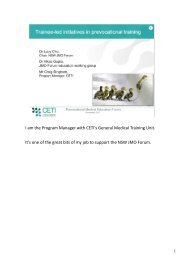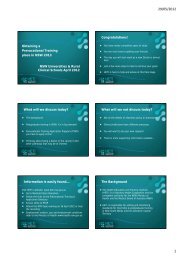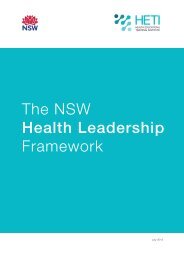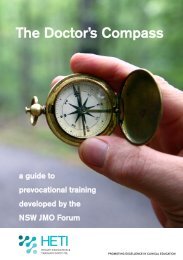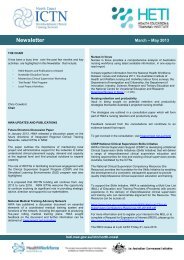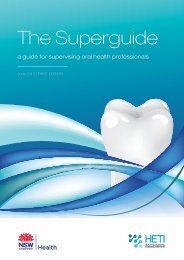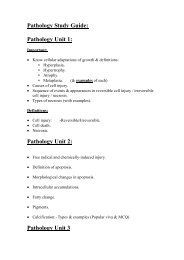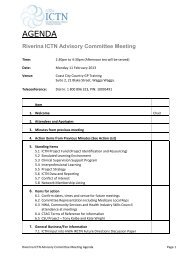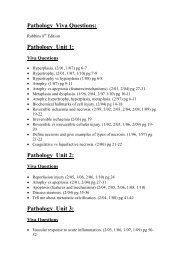Pharmacology Study Guide: Pharmacology Unit 1 ... - HETI
Pharmacology Study Guide: Pharmacology Unit 1 ... - HETI
Pharmacology Study Guide: Pharmacology Unit 1 ... - HETI
Create successful ePaper yourself
Turn your PDF publications into a flip-book with our unique Google optimized e-Paper software.
<strong>Pharmacology</strong> <strong>Study</strong> <strong>Guide</strong>:<strong>Pharmacology</strong> <strong>Unit</strong> 1: Drug receptors Dose - response curves. Types of antagonists. Second messengers. Efficacy vs. Potency.Definitions (use EXAMPLES where appropriate) Drug. Receptor. Pharmacodynamics. Agonist / Partial agonist / Antagonist. Potency. Efficacy. ED 50 / TD 50 / LD 50 Therapeutic index (ie therapeutic ratio).<strong>Pharmacology</strong> <strong>Unit</strong> 2:Definitions (use EXAMPLES) Pharmacokinetics. Volume of distribution. Clearance. Elimination:capacity-limitedflow-limited Zero / First / Mixed order kinetics. Half-life. (including formula) Bioavailability. Extraction ratio. First-pass elimination. Phase 1 and 2 reactions. Enzyme induction and inhibition
<strong>Pharmacology</strong> <strong>Unit</strong> 3: Inhaled anaesthetic agents: Nitrous Oxide (Important). Volatile agents (Learn as a group rather than individualagents).-PK and PD particularly.-Need to understand concept of MAC. IV anaesthetic agents: Sodium thiopentone Propofol. Ketamine. Local anaesthetic agents: Lignocaine. Prilocaine. Bupivacaine. PK / PD / Safe doses / Toxicity of particular note.<strong>Pharmacology</strong> <strong>Unit</strong> 4: Non-depolarising muscle relaxants; be familiar with:- Pancuronium. Vecuronium. Atracurium. Rocuronium There may be a few MCQs about the original NDPMRseg d-Tubocurarine. Depolarising muscle relaxants:- Suxamethonium- IMPORTANT drug.- Understand differences vs. NDPMRs.- Phase II block.- Contraindications / Side effects.- Pseudocholinesterase deficiency. Dantrolene. Malignant Hyperthermia. Anatomy & neurotransmitter chemistry of the Autonomic NervousSystem. Autonomic receptors. Presynaptic & postsynaptic regulation. <strong>Pharmacology</strong> of the eye
<strong>Pharmacology</strong> <strong>Unit</strong> 5:Important: Direct-acting cholinergics (nicotinic / muscarinic). Indirect-acting cholinergics (i.e. Cholinesterase inhibitors). alcohols (Edrophonium). carbamates (Neostigmine). organophosphates (including poisoning & Pralidoxime). Anticholinergics (Atropine). Adrenoceptor types & distribution. Second messengers (broad concepts). Organ system effects. Adrenaline Noradrenaline Isoprenaline Dopamine. Dobutamine.<strong>Pharmacology</strong> <strong>Unit</strong> 6:Revision Week<strong>Pharmacology</strong> <strong>Unit</strong> 7:Important: Clinical pharmacology of alpha blockers. Alpha blockers:-Phenoxybenzamine-Phentolamine.-Prazosin. Beta blockers: -Organ system effects. Specific agents: -Propranolol.-Metoprolol / Atenolol. ( 1 selective).-Labetalol worthy of superficial knowledge.-Esmolol also interesting because of short T 1/2 anduse in SVT.
Know which agents exhibit cardioselectivity, intrinsicsympathomimetic activity, local anaesthetic action etc.(Table 10-2 and common examples of each) Clinical pharmacology of beta blockers. Beta blocker toxicity / overdose.<strong>Pharmacology</strong> <strong>Unit</strong> 8: Anti-hypertensive agent classes Methyldopa:* Mechanism of action, bioavailability. Clonidine: Mechanism of action. Ganglion-blockers: Know what they do (for MCQs). Know some of their names. Know something about their toxicity. (the reason for theirwithdrawal from the market) Hydralazine Sodium Nitroprusside: Interesting drug, particularly with regard topharmacokinetics, pharmacodynamics and toxicity. ACE inhibitors: Generic features. Captopril. Enalapril (is a “prodrug”, NB for MCQs).Angiotensin receptor blockers (e.g. Losartan)<strong>Pharmacology</strong> <strong>Unit</strong> 9: Nitrates:-Need good understanding of PK and PD.-Table 12-2 for MCQs / Vivas. Calcium channel blockers:-Dihydropyridines -Nifedipine (learn this one asrepresentative).-Amlodipine.-Felodipine.
-Verapamil.-Diltiazem.-Passing familiarity with Nimodipine. Review of cardiac contractility and excitation-contraction coupling. Review of factors affecting cardiac output. (“cardiac performance”).Digoxin (Important drug): Particularly PK, PD and interactions. Digoxin toxicity. Digoxin-specific antibodies (Digibind). Other drugs used in CHF: Inotropes. Diuretics (covered later) Vasodilators.<strong>Pharmacology</strong> <strong>Unit</strong> 10: Review of electrophysiology of cardiac conduction. Mechanisms of arrhythmias (re-entry etc.). Anti-arrhythmic drugs are classified using the Vaughan-Williamssystem. (The underlined drugs are important.) Class 1A: Class 1B: Class 1C:Quinidine / Procainamide / TCAsLignocaine / PhenytoinFlecainide Class 2: Beta-blockers (already covered) Class 3: Amiodarone (also Class 1, 2 and 4)Sotalol (also Class 2) Class 4: Calcium channel blockers (Verapamil). Others:Adenosine.Digoxin (already covered).Magnesium.<strong>Pharmacology</strong> <strong>Unit</strong> 11:Chapter 15 Overview of renal function. Classification & mechanism of action of diuretics as a group
Specific drugs: carbonic anhydrase inhibitors osmotic diuretics loop diuretics thiazides K sparing agents aldosterone antagonistsChapter 35 Overview of lipoprotein disorders HMG CoA Reductase inhibitors (eg simvastatin) Niacin (Vit B3) Fibrates (eg gemfibrozil)<strong>Pharmacology</strong> <strong>Unit</strong> 12: Heparin (unfractionated). LMW Heparin. Protamine. Warfarin. Streptokinase. t-PA. Aspirin (antithrombotic effects). Clopidogrel Vitamin K. Blood products: FFP. Cryoprecipitate. Factor VIII. Factor IX.<strong>Pharmacology</strong> <strong>Unit</strong> 13:Revision Week
<strong>Pharmacology</strong> <strong>Unit</strong> 14: Agents used for asthma: Sympathomimetics (salbutamol) Methylxanthine (Theophylline - worth knowingPK/PD/Overdose) Anti muscarinic - Ipratropium. Steroid inhalers Sodium cromoglycate (basic).<strong>Pharmacology</strong> <strong>Unit</strong> 15:Chapter 43 Penicillins: Cephalosporins: Vancomycin.Chapter 44 Tetracyclines. doxycycline. Macrolides. -erythromycin-azithromycin ChloramphenicolNatural penicillins e.g. benzylpenicillin.Anti staphyl penicillins e.g. flucloxacillinBroad-spectrum penicillins e.g. ampicillin.4 generations (with examples).Compare / contrast the four generations.<strong>Pharmacology</strong> <strong>Unit</strong> 16:Chapter 45 Aminoglycosides.-gentamicin.Chapter 46 Sulfonamides. Trimethoprim. Quinolones.Chapter 47 Isoniazid
<strong>Pharmacology</strong> <strong>Unit</strong> 17:Chapter 48 Azoles - fluconazoleChapter 49 Anti-virals:-Aciclovir-AZT.-AmantadineChapter 50 Metronidazole Nitrofurantoin Antiseptics<strong>Pharmacology</strong> <strong>Unit</strong> 18:Revision Week<strong>Pharmacology</strong> <strong>Unit</strong> 19:Chapter 21 Sites of drug action NeurotransmittersChapter 22 Benzodiazepines: Midazolam. Diazepam. Flumazenil. Zolpidem
<strong>Pharmacology</strong> <strong>Unit</strong> 20:Chapter 23 Ethanol: PK (particularly metabolism). PD / Organ system effects. Withdrawal. Naltrexone / Disulfiram Methanol / Ethylene glycol: Mainly relating to toxicity.Chapter 24 Review of seizure types. Phenytoin (IMPORTANT DRUG): Pharmacokinetics of particular note (variable order kinetics;metabolism becomes saturated within the therapeuticrange). Toxicity. Interactions. Carbamazepine. Some knowledge of: -Phenobarbital-Newer drugs eg. Lamotrigine, gabapentinSodium valproate.<strong>Pharmacology</strong> <strong>Unit</strong> 21: Antipsychotic agents: Basis of action (Dopamine hypothesis etc). Types:-Phenothiazines (Chlorpromazine)- Butyrophenones (Haloperidol)- Atypical (Olanzapine, risperidone) Lithium (with particular reference to overdose).
<strong>Pharmacology</strong> <strong>Unit</strong> 22: Antidepressants: Basis of action (neurotrophic and monoamine hypothesis). SSRIs: -Fluoxetine as typical agent.-Serotonin syndrome. SNRIs: -Venlafaxine TCAs: -Learn features as a group.-Main thrust of questions will be toward overdose. Tetracyclics: -Superficial knowledge. MAO inhibitors: -Emphasis on toxicity / overdose.-Drug interactions is a good MCQ.<strong>Pharmacology</strong> <strong>Unit</strong> 23:Chapter 31 Opioid peptides and receptor types (table 31-1) PK / PD /Toxicity etc. as a group.Specific agents to know: MorphineFentanyl.Codeine.Tramadol Need some familiarity with: Methadone.Heroin. Buprenorphine (Temgesic) is of interest as a partial agonist. Naloxone.Chapter 32 GHB Cocaine Amphetamines<strong>Pharmacology</strong> <strong>Unit</strong> 24:Revision Week
<strong>Pharmacology</strong> <strong>Unit</strong> 25:Chapter 38 Anti-thyroid drugs (basic understanding): Thioamides CarbimazolePropylthiouracil.Chapter 39 Radioactive Iodine. Glucocorticoids: Very important drugs Hydrocortisone. Prednisone. Effects / indications. Table of relative potencies table 39-1 (MCQ) Mineralocorticoids: Aldosterone.<strong>Pharmacology</strong> <strong>Unit</strong> 26: Insulin secretion / structure / actions (overlap with Physiology). Insulin (Important): Preparations. Delivery system. Complications of therapy. Oral hypoglycaemics: Learn as groups rather than individual agents. Sulphonylureas. Biguanides. Glucagon. Effects. Indications (e.g. Beta-blocker OD, Oesophageal FB).
<strong>Pharmacology</strong> <strong>Unit</strong> 27: Histamine. H 1 antagonists: 5-HT agonists: 5-HT antagonists: Ergot alkaloids:-Promethazine.-Sumatriptan.-Ondansetron.-Ergotamine.<strong>Pharmacology</strong> <strong>Unit</strong> 28: Aspirin (Important drug).PK: -Gastric trapping. -Variable-order kinetics. -Acceleration of excretion by urinaryalkalinisation.PD.Overdose Cyclo-oxygenase inhibitors Other NSAIDs:Know that there are 7 classes. Learn generic features rather then individual agents, but knowwhich agents have specific uses e.g. Indomethacin for PDA. Paracetamol (Important, especially in overdose.)Need some familiarity with Rumack-Matthew nomogram. N-acetylcysteine. (basic knowledge e.g. proposed mechanism ofaction, dose). Colchicine (basic knowledge, relating particularly to overdose). Allopurinol (basic knowledge only).<strong>Pharmacology</strong> <strong>Unit</strong> 29: Antacids. H2 antagonists:
-Cimetidine as prototype (also interesting for it’s interactions).-Familiarity with the others as well. Proton pump inhibitors (Omeprazole) Metoclopramide Passing familiarity with laxatives & anti-diarrhoeals. Prochlorperazine Octreotide<strong>Pharmacology</strong> <strong>Unit</strong> 30:Revision Week<strong>Pharmacology</strong> <strong>Unit</strong> 31:Chapter 57 <strong>Pharmacology</strong> of chelatorsChapter 58 Initial management of poisoned patient Methods of G-I decontamination. Specific antidotes (Table 58-4) Substances eliminated by dialysis (table 58-3) Common toxic syndromes<strong>Pharmacology</strong> <strong>Unit</strong> 32:Chapter 59 Drug therapy in pregnancy Drug therapy in childrenChapter 60 <strong>Pharmacology</strong> in aging
Major drug groupsAppendix Active and passive immunisation



